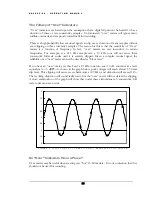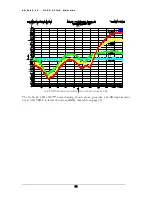
Chapter
5
A D 2 4 0 2 - 9 6 - O P E R A T I N G M A N U A L
“FSD” Meters
What is “FSD”?
There are several different ways of labeling the clip LED on a digital meter. These include; 0
dBFS, Clip, Over, and FSD.
“FSD” stands for “
F
ull
S
cale
D
igital” and has a very specific and slightly different meaning than
“0 dBFS”, or “Over”. It is important to understand the difference.
The “FSD” indicator will light whenever the minimum or maximum digital code of the converter
is reached for a duration of one sample or more. No other digital codes will ever cause the “FSD”
indicator to light.
How is “FSD” Different from “0 dBFS”?
Ideally there is no difference, but in practice, 0 dBFS has often been used to describe any digital
code which is very close to full scale. “FSD” is used to describe only the minimum and maximum
digital code.
An “FSD” meter must have knowledge of the digital word length in order to work properly. A
16-bit “FSD” code will not register “FSD” when feeding a “FSD” meter that is expecting a 20-bit
word length. The reason for this is that the 16-bit word will have 4 trailing zeros appended to it
(to make it a 20-bits word), and the 20-bit “FSD” meter will interpret this as a level which is 16
codes below full scale. Fortunately testing for non-changing trailing bits easily solves this problem.
How is “FSD” Different from “Over”?
An “Over” indicator (as specified in the Sony 1630 OVER standard) will only light if a minimum
or maximum digital code is reached for three or more consecutive samples. One or two
consecutive full-scale digital codes are not considered an “Over”. Some “Over” meters deviate
from the Sony standard and allow the selection 4, 5, or 6 contiguous full scale codes before
indicating an over.
24
















































